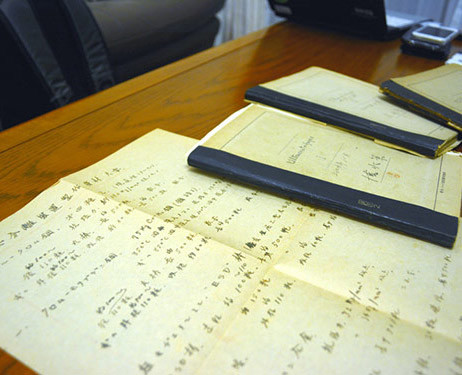A tantalizing glimpse of some Japanese notebooks dating back to World War II:

“Long-forgotten documents on Japan’s attempt to build an atomic bomb during World War II have been discovered at Kyoto University, which experts say further confirms the secret program’s existence and could reveal the level of the research. The newly found items, dating between October and November 1944, were stored at Kyoto University’s research center. Research into uranium-enrichment equipment, a key to the production of atomic weapons, was scribbled in three of the notebooks. Japan surrendered in August 1945 before the secret project could reach fruition. “The new data could show us the level of research they were involved in,†said Hitoshi Yoshioka, a professor who studies the history of scientific technology at Kyushu University. It has long been known that two programs were under way in Japan to produce a nuclear weapon during the war. One, commissioned by the Imperial Japanese Navy and code-named “F Research,†involved Bunsaku Arakatsu, a professor of physics at Kyoto Imperial University, the predecessor of Kyoto University, and other leading researchers at the institution. The other, carried out by the Imperial Japanese Army and known as the “Nigo Research†project, was spearheaded by Yoshio Nishina, a physicist at the Riken institute in Tokyo. Yoshioka, well versed in the development of nuclear-related technology, noted that there are few known documents on the research that took place at Kyoto Imperial University compared with that conducted at Riken. The notebooks in question belonged to Sakae Shimizu, a researcher who worked for Arakatsu.”
Read more at Wartime documents shed light on Japan’s secret A-bomb program – AJW by The Asahi Shimbun

This extract from the Tonizo Dossier my be of interest.r.
Meeting on Uranium research at the Nishina laboratory. 6th July 1943.
Attendance: Dr. Nishina, Gen. Nobu-uji, Ishida ( gishi / engineer ?)
From page 4 of 5.
Dr. Nishina; The minimum mass of uranium 235 is about 10Kg and is determined by the balance between the neutrons generated by fission and those lost though the surface. If too many are lost then there will be no sustained chain reaction. Though this critical mass is about 10 Kg, it will not make a bomb, there needs to be extra, assume an extra 10 Kg (1).
Gen. Nobu-uji asks if this extra will also under go fission. Nishina says, no, only a portion will undergo fission, the rest will be lost in the explosion (2).
At present it is not within our capability to implement such a device.
There are other reasons why a bomb is not practical and therefore not recommended ( fu-tokusaku. In order to achieve the largest possible explosion, the bomb needs to be held ( hoji ) together for 1/30 to 1/20 [micro]* second and to achieve this it requires a large and heavy tamper or reflector (3). The weight would be enormous ( jindai ), therefore it is considered impractical and as a bomb not suitable ( tekito narazaru ).
Footnote;
(1) Modern nuclear parameters yield a critical mass for U235 of about 17 Kg with a substantial reflector. The Hiroshima bomb used 80% U235 and was about 2.8 critical masses.
(2) Only about 700 grams of U235 out of 64 Kg underwent fission at Hiroshima., the rest being lost in the explosion.
(3) Due to the exponential increase of the fission process, 99.5% of the energy is released in the last 4.6 fission periods. At about 10 nano-seconds per period this is 46 nano-seconds or approx. 1/25 micro-second. During this period the energy released must overcome the inertia of the tamper holding ( hoji suru ) the device together.
* The word micro is missing from the text, micro-second = haku man bun no ichi byo.